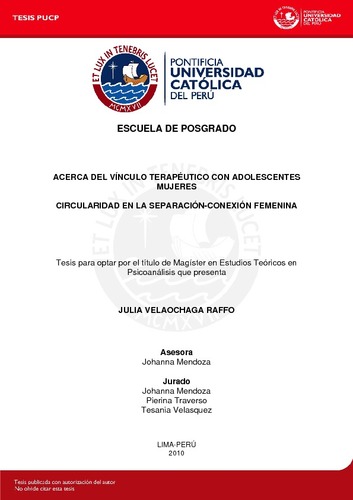| dc.contributor.advisor | Mendoza Talledo, Johanna Elena | |
| dc.contributor.author | Velaochaga Raffo, Julia María | es_ES |
| dc.date.accessioned | 2014-05-16T21:27:49Z | es_ES |
| dc.date.available | 2014-05-16T21:27:49Z | es_ES |
| dc.date.created | 2010 | es_ES |
| dc.date.issued | 2014-05-16 | es_ES |
| dc.identifier.uri | http://hdl.handle.net/20.500.12404/5323 | |
| dc.description.abstract | El objetivo de esta investigación es describir y explicar las particularidades del vínculo terapéutico entre una analista mujer y una adolescente a partir del estudio de la visión circular de los procesos de separación-individuación y de la visión bipolar del self, descritas por el modelo intersubjetivista de la mente. Benjamin (1997) subraya que ambos miembros de la díada viven la experiencia de reconocimiento del otro tanto como sujeto y como objeto simultáneamente. El otro es un igual con el cual identificarse promoviendo así las relaciones de mutualidad. Se darían oscilaciones continuas de re-visión o re-síntesis de representaciones del “self-versus-la-madre” y “self-con-la-madre” a largo de la vida (Bernstein, 2004). En tanto el vínculo estudiado se trata de mujeres, se toman aportes de la teoría de género y de las concepciones sobre femineidad sobre todo las referidas al vínculo primario maternal (Kristeva, 1980; Alizade, 1999, 1992, 1991; Irigaray 1988 y Montrelay, 1980). Estos aportes son integrados con propuestas sobre técnica y manejo del vínculo terapéutico sugeridas por Raphael-Leff (1997) y Perelberg (1997). Se subraya la importancia de la articulación y alternancia entre formas de comunicación primaria, no-verbal y otras, elaboradas o verbales para la construcción de un proceso de reconocimiento mutuo en el espacio terapéutico intersubjetivo (Person, 2007). Esta articulación facilita la expresión de conductas paradojales, la manifestación de diferencias, la afirmación de identificaciones, y constituye una visión alternativa al tratamiento de adolescentes mujeres que promueve la separación con conexión a través de la contención. | es_ES |
| dc.description.abstract | The aim of this research is to describe and explain the particularities of the therapeutic relationship between a female analyst and an adolescent departing from the study of a circular vision of individuation –separation processes and the bipolar vision of self which have been described by the intersubjective model of mind. Benjamin (1997) emphasizes that both members of the dyad live the experience of recognizing the other as a subject and object simultaneously. The other is an equal that you can identify with promoting mutuality relationships. Continuous oscillations of re-vision or re-synthesis of “self vs. mother” and “self with the mother“ representations could take place along life (Berenstein, 2004). As we are studying a relationship between women, we review the gender theory and femininity conceptions, mostly the ones referring to the primary maternal bonding (Kristeva, 1980; Alizade, 1999, 1992, 1991; Irigaray 1988 and Montrelay, 1980). These contributions are integrated with proposals referred to the technique and the ways to handle the therapeutic relationship suggested by Raphael-Leff (1997) and Perelberg (1997). We underline the importance of the articulation between primary, non-verbal and other communication forms, verbal or elaborated for the construction of a mutual recognition in the intersubjective therapeutic space (Person, 2007). This articulation facilitates the expression of paradoxical behaviors, the manifestation of differences, the affirmation of identifications and constitutes an alternative vision of the treatment of female adolescents that promotes a separation-connection from holding. | es_ES |
| dc.language.iso | spa | es_ES |
| dc.publisher | Pontificia Universidad Católica del Perú | es_ES |
| dc.rights | info:eu-repo/semantics/openAccess | es_ES |
| dc.rights.uri | http://creativecommons.org/licenses/by/2.5/pe/ | * |
| dc.subject | Psicoanálisis | es_ES |
| dc.subject | Mujeres--Psicología | es_ES |
| dc.title | Acerca del vínculo terapéutico con adolescentes mujeres circularidad en la separación-conexión femenina | es_ES |
| dc.type | info:eu-repo/semantics/masterThesis | es_ES |
| thesis.degree.name | Maestro en Estudios Teóricos en Psicoanálisis | es_ES |
| thesis.degree.level | Maestría | es_ES |
| thesis.degree.grantor | Pontificia Universidad Católica del Perú. Escuela de Posgrado | es_ES |
| thesis.degree.discipline | Estudios Teóricos en Psicoanálisis | es_ES |
| renati.discipline | 313107 | es_ES |
| renati.level | https://purl.org/pe-repo/renati/level#maestro | es_ES |
| renati.type | http://purl.org/pe-repo/renati/type#tesis | es_ES |
| dc.publisher.country | PE | es_ES |
| dc.subject.ocde | https://purl.org/pe-repo/ocde/ford#5.01.00 | es_ES |






